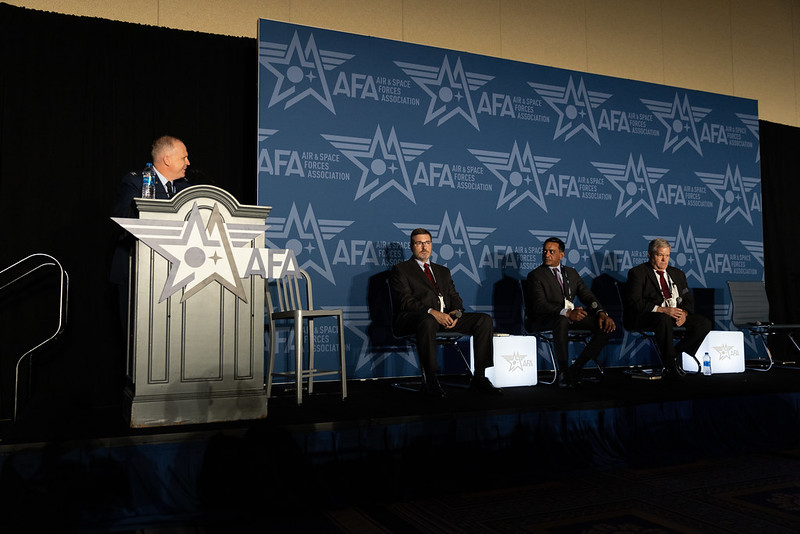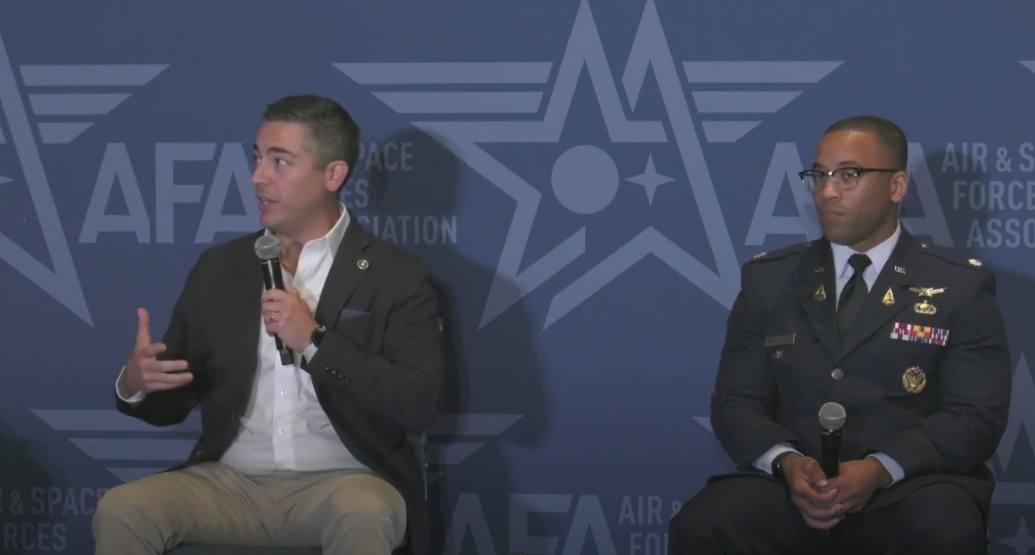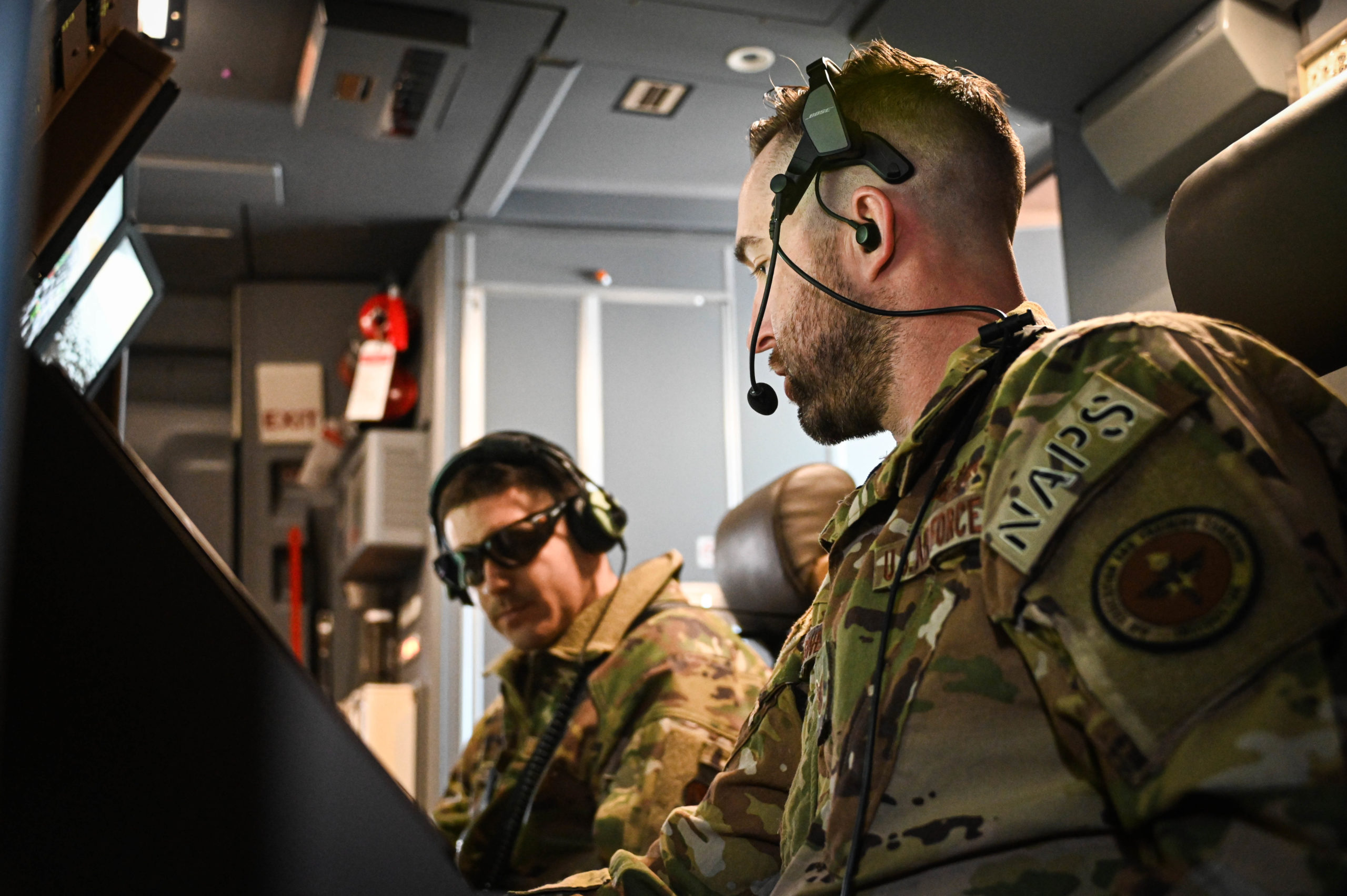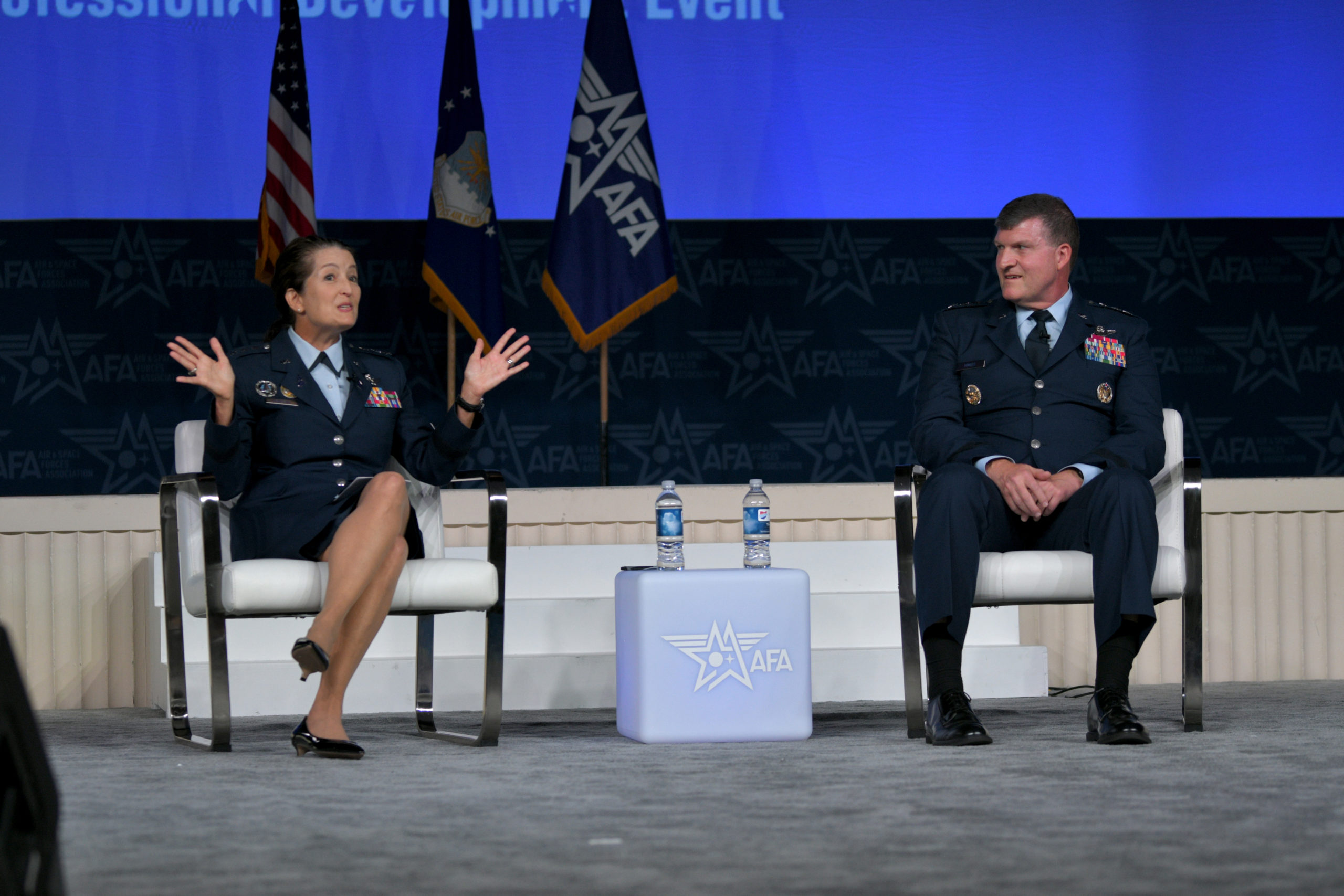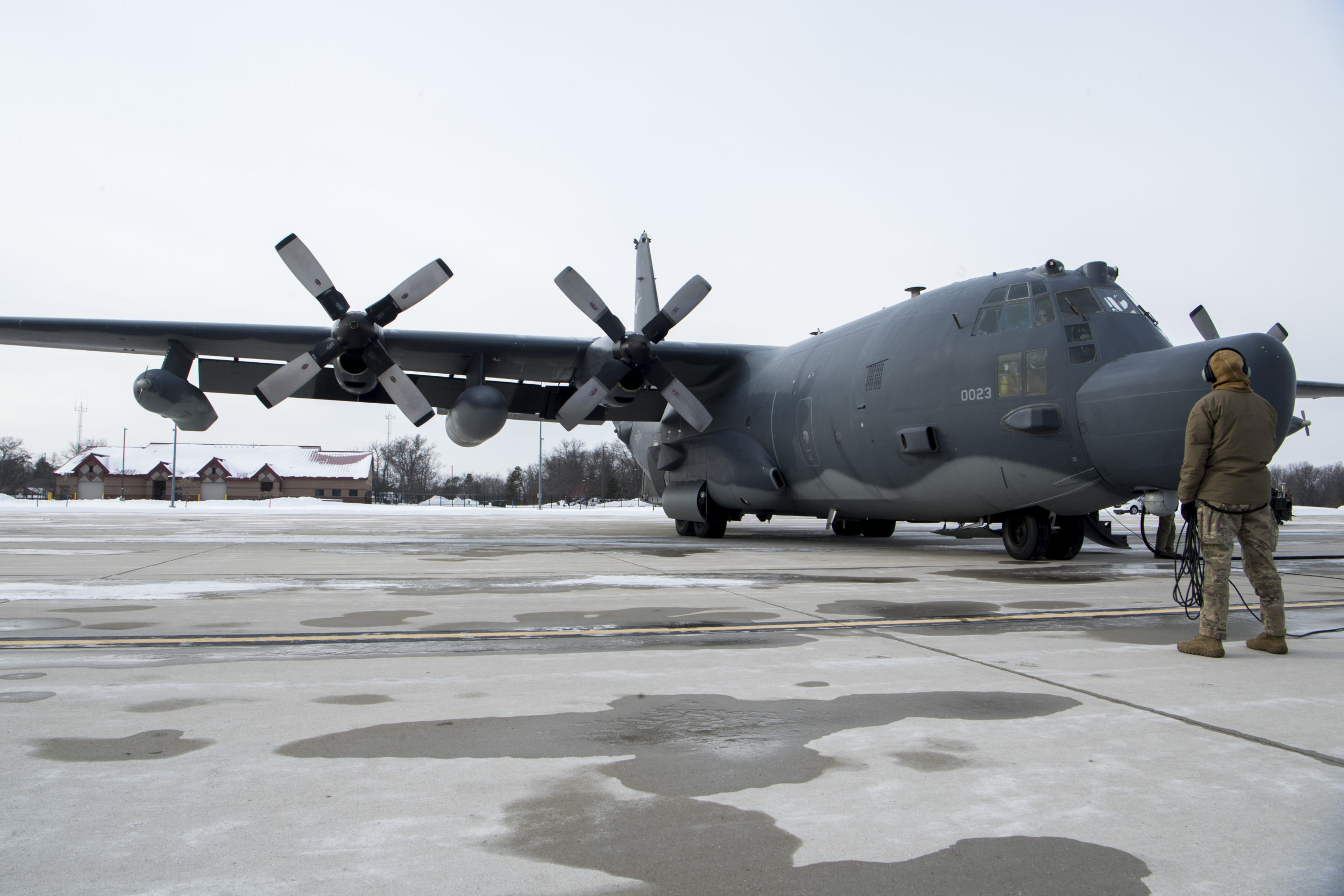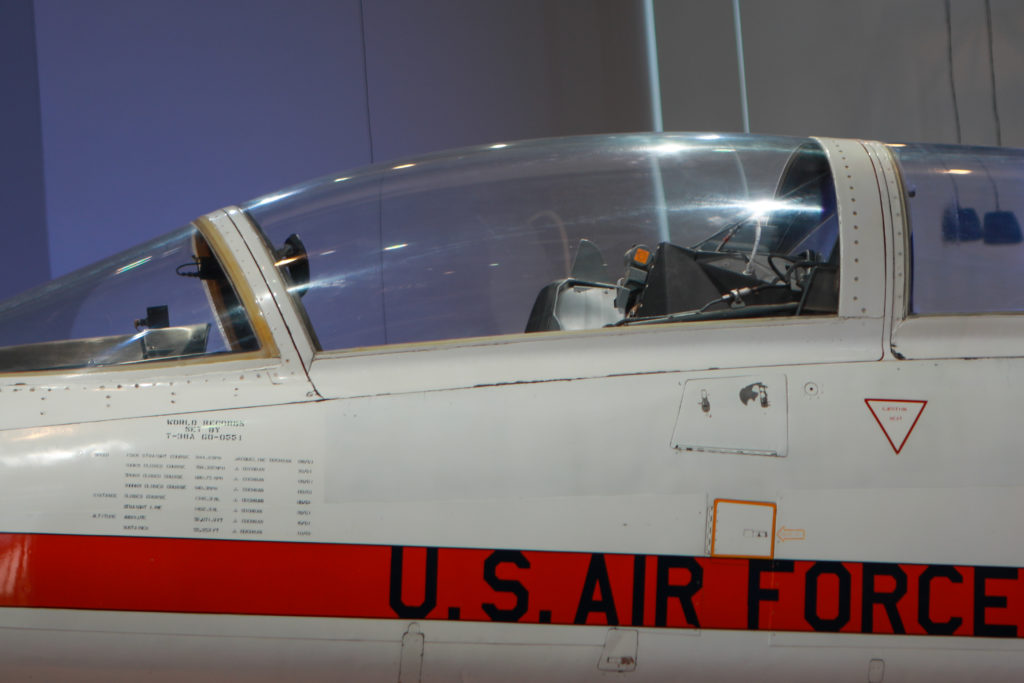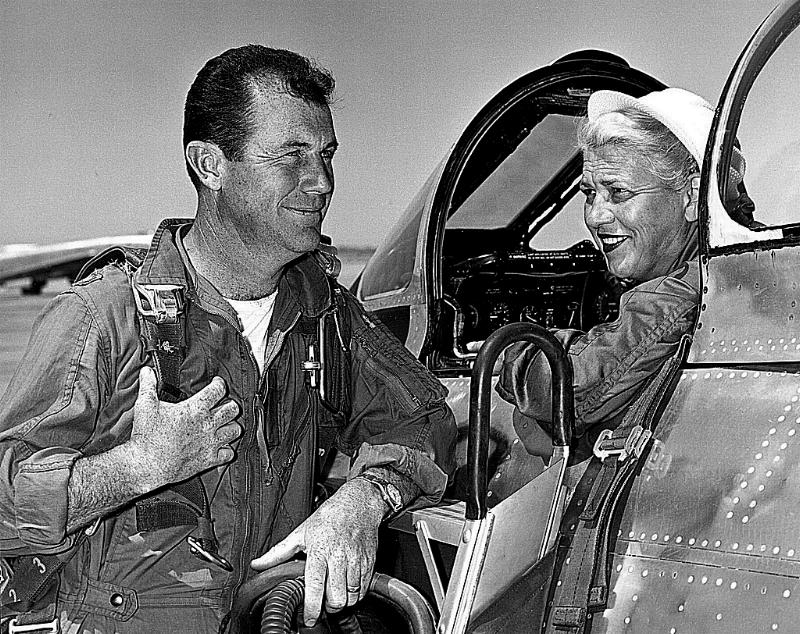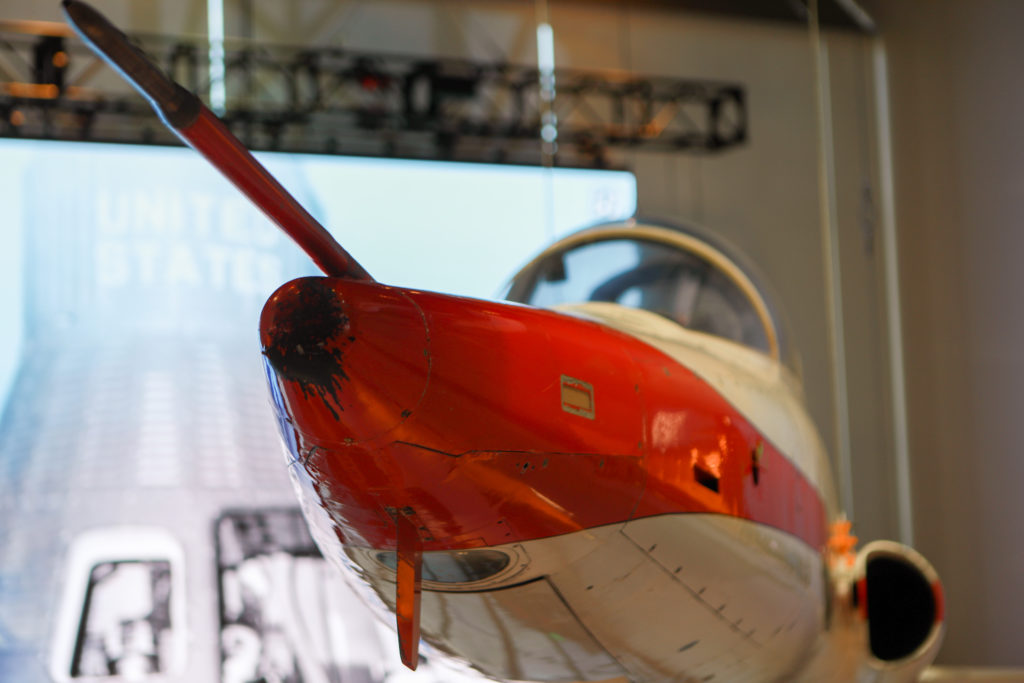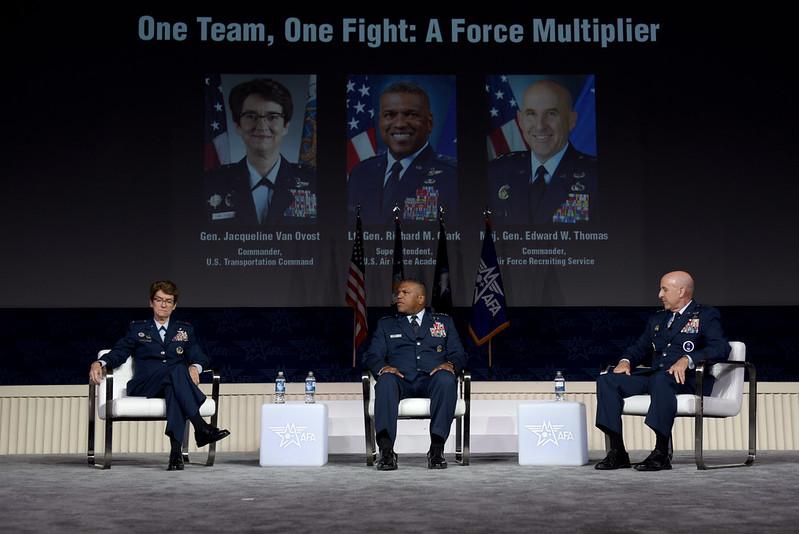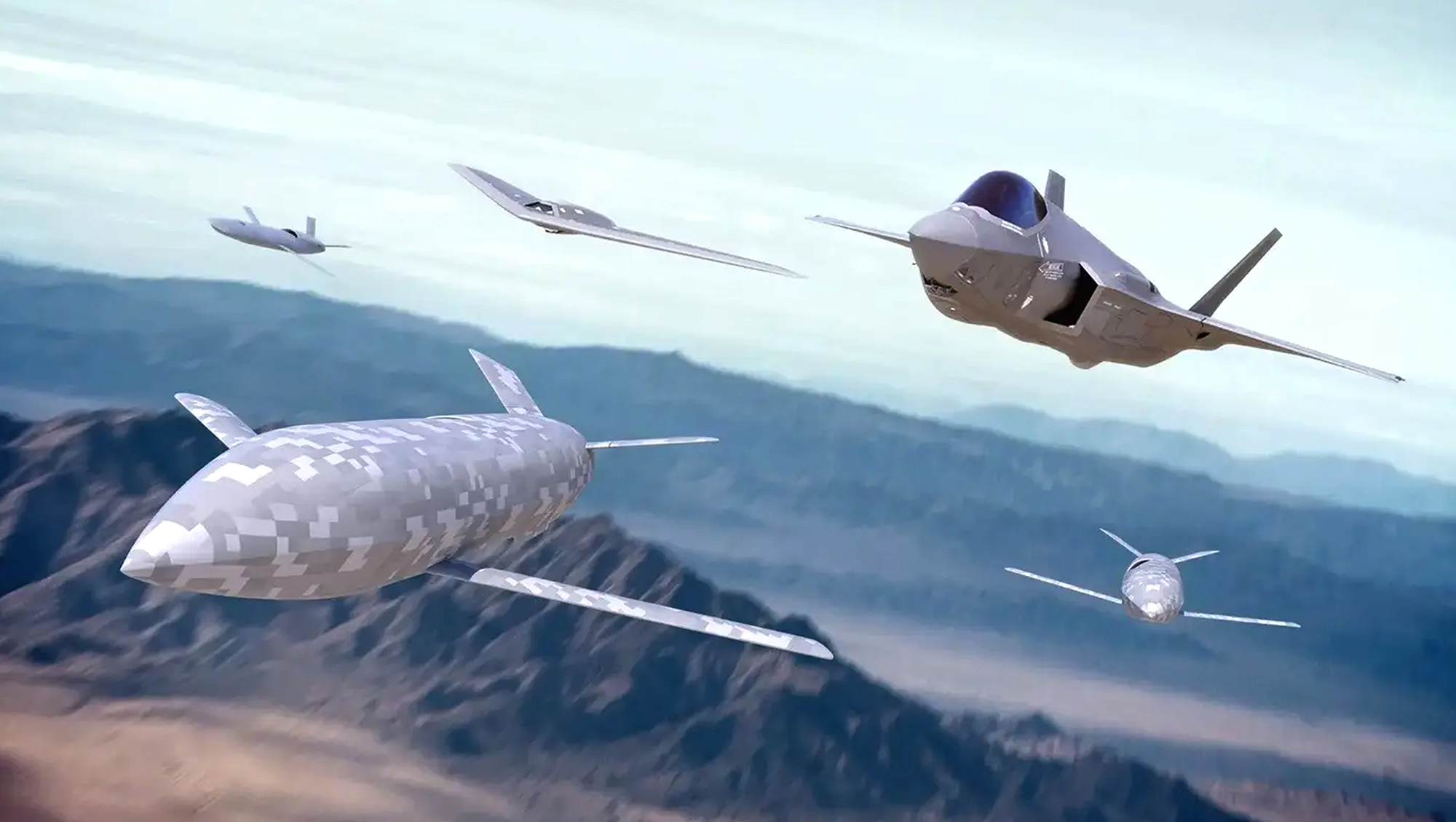Brig. Gen. Jason Bartolomei, program executive officer for Weapons, led a discussion on “Standards and Digital Engineering” with Naveed Hussain of Boeing, Layne Merritt of Elbit Systems of America, and Alan England of L3Harris Technologies, Sept. 19, 2022, at AFA’s Air, Space & Cyber Conference. Watch the video or read the transcript below. This transcript is made possible through the sponsorship of JobsOhio.
If your firewall blocks YouTube, try this link instead.
Brig. Gen. Jason Bartolomei:
Well, welcome everybody to the afternoon session on digital engineering. We’re really excited to have you here and we’ve got a great panel for you. I know this morning when I heard from the secretary and the chief, it was very motivating words, and I think we’re really blessed to have forward leaning chief and secretary really, really inspiring us to accelerate change in the future. This topic that we’re going to talk about today, I think is one of the most exciting areas, particularly in the world of the industry military partnership. And that is our digital transformation. We’ve got a really great panel of leading experts and thinkers.
Starting first year with Layne Merritt from Albert Systems America. He’s Vice President of Technology and Innovation. Dr. Naveed Hussain, Vice President and Chief Engineer for Boeing Defense Space and Security, and Dr. Allen England, L3 Harris Director, Strategic Programs, Advanced Systems Technology, Agile Development Group. Sometimes when we get medals, we have long titles in the military, and I see that nothing’s different in industry. Now we just wrapped up my fantasy draft, and so I thought maybe we have a little snake question here where we’ll go through the panel and ask some questions in the spirit of fantasy football.
I thought maybe I would start at the end with you, Dr. England. I think my question begins with, from your perspective in the entire panel, where exactly are we today on the road towards our digital future? Do you see us at the beginning? Are we in the middle state here, or are we an end game? Where do you place us?
Dr. Alan England:
Thanks for the question yeah. I see us as not at the very beginning, but transitioning from the beginning to the middle. We understand what digital engineering means now. 10, 15 years ago, maybe not, but as I was preparing for this, it surprised me to learn that SysML actually started back in 2000, and then in 2007 was when MBSE 2020 was actually published by INCOSE. So digital engineering has been growing, it’s been evolving, but I think we’ve gotten to that point where we’re at the knee and the curve where it’s starting to really take off.
Brig. Gen. Jason Bartolomei:
Great. Dr. Hussain, any thoughts from your perspective in Boeing?
Naveed Hussain:
Yeah, I just to add on to my colleague, I think we’re in the middle if we zoom out on the S-curve of model-based system engineering in an integrated digital environment, we have been working with digital models, physics-based digital models for decades. That is how we’ve optimized our designs, that’s how we’ve optimized the way we think about test, and that’s how we’ve thought about optimizing across the life cycle. I think what’s accelerating now as we are in that middle of the S-curve is how all these models interconnect and how we think about not just the platform, but the production system and the sustainment system altogether.
Brig. Gen. Jason Bartolomei:
Oh, excellent. Any thoughts from Albert?
Layne Merritt:
Sure. So I think we’re in the middle or in the beginning to middle transition. I think the new thing now, as you said, we’ve been doing digital models for a long time. Functional models, right? We could do thermal analysis, structural analysis, system dynamics, but putting those together, connecting them to the requirement and be able to simulate the entire system as we’ve never done before, is going to be the game changer.
Brig. Gen. Jason Bartolomei:
Fantastic. Dr. Hussain, in the same spirit, in my first engagement with the secretary right after he became SecAF, we gave him an update. One of the questions he asked me, I’ll ask you is, do you see what’s happening as an evolutionary change or a revolutionary change for how it is that we’re doing what we do?
Naveed Hussain:
I think it’s revolutionary. While pieces of it might look evolutionary when we think about how we optimize at the platform level, interconnecting various digital models, I think it’s revolutionary as we move from these digital system models for the platform to interconnecting those models to the production and the sustainment system, and then evolving from digital system models for design development and test and integration to digital twins to sustain the fleet. And that opens up a whole new category of innovation and I think, a game changing, a revolutionary capability for our customer.
Brig. Gen. Jason Bartolomei:
Layne, any thoughts on revolutionary versus revolutionary?
Layne Merritt:
Sure. I think it’s revolutionary. I think what we’re going to be able to do, connecting the various models that we had before, the interaction that we can have between not only the customer and the OEM, but the OEM and the lower system suppliers is going to really change the game and bringing this into the production line and the supply chain is really a big game changer.
Brig. Gen. Jason Bartolomei:
Great. How about you, Dr. England?
Dr. Alan England:
I agree with them. It’s a revolutionary way of doing engineering. It’s a revolutionary in that the amount of data that is available to the engineers as we start making these systems and analyzing these systems and looking at alternatives, that data that’s available through the model is data that’s never been available in the quantity and the interaction that we can get when we put the data in the model and interact with it in the model environment.
Brig. Gen. Jason Bartolomei:
I had the opportunity to go to the UK and see how F1 does their business. It was interesting that if you look at their journey, they started their journeys about eight to nine years ago, and they’re to the point now where they are making improvements to their Formula One cars every 20 minutes, 365 days a year. I really think that Dr. Hussain your comments about what does it mean for the fabrication and the production and the sustainment is really thought-provoking. I’d be interested to say, are there any areas that you see as revolutionary that we’re not talking enough about currently? And maybe Mr. Merritt, why don’t you start lane and maybe say your thoughts on that and then we’ll go through.
Layne Merritt:
I think there’s two things from the Albert America perspective. First, the subsystem suppliers, and we do a lot of mission systems, black boxes, sensors and things like that. We don’t have to wait for the OEMs to finish their design or to get fairly well down the road in their design before we start designing. If the customer publishes and architectural framework, all the interfaces, the performance requirements, they’re all defined. How that happens in the end as part of the competitive nature of business. The other thing is how this fits into the industrialization process. We talk so much about the design and then the operational use stages.
For industry, how we industrialize that, how we manufacture it, and how we manage the supply chain can make or break a program. Digital engineering, the models of the system flow right into the production process, the manufacturing floor, and then to the supply chain process, and it’s going to make us much more effective.
Brig. Gen. Jason Bartolomei:
Yeah. Dr. Hussain?
Naveed Hussain:
Yeah. One of the things that I think we should talk more about is the experience at the desk of the engineer. At this point, an engineer at her desk has the ability to think about the trades that she’s making in the work that she’s doing at her section of the life cycle, whether it’s design or integration or sustainment or production, and how that decision affects the entire life cycle and the trades that, that unlocks between performance and producibility and the value engineering that, that will unlock for the customer. The knobs that can be turned at the desk of an engineer, as Will Roper says, they’re sort of a godlike power. I think there’s an important story here that we need to talk more about to inspire the early generation, the early career engineer, and even the students on why they should come into our industry and the capability that they’re going to have to change the world.
Brig. Gen. Jason Bartolomei:
Dr. England?
Dr. Alan England:
I agree with that a lot. The people that I interact and work with a lot, I tell this story that I’ll share with you, and it’s about back when I was a young engineer and you wanted to go start evaluating at change, you had two or three systems engineers on a program, but one of them knew the requirements really well. You would go talk to him or her and you would say something about, “What’s going to happen if I change… Fill in the blank.” this person either looks at the ground or looks at the ceiling, depending on if they’re introvert or extrovert, and they say something like, “And what’s going on?” As they’re going through the Rolodex of requirements in their minds. And they say, “Well, you need to go check on 26, 27, 33, 198 and 227.”
Those are the requirements that they have been tracking through the whole life of the program. Now, that’s one example of what you get to do as my colleague next to me was saying that the engineer gets to do on their desk. That happens inside the model in realtime. So as things are changed, you start to see across the full system of how those requirements are being met or maybe one is not being met now and it’s unbelievably powerful.
Brig. Gen. Jason Bartolomei:
Well, it’s an anecdote. I remember pulling one of the chief engineers aside in the last couple years and asking him 40 years of experience, done everything. I said, “What do you think?” His response to me was, “I like it. I love it.” He said to me that in his 40 years, he would ask his engineers a question and he’d have in his mind, to your point, Dr. England about it, might take him a two weeks before they get back to me on an answer. Because I know what they would have to do to get that. Their engineers are coming back in a day and saying, “Hey chief, we’re ready. Let’s talk about what we learned.” And he’s just blown away at how quickly his young engineers are able to come to him and show him what’s going on.
That speed has some huge benefits, but I have a feeling to really, the bridge you made for us, Dr. Hussain, is there’s something in the human terrain that we need to talk about. I guess Dr. England, could you talk us a little bit from just the human terrain of your company, organization, culture, process. What is digital? What is it meaning for your company and how you’re leading? Are there things that you’re having to think differently about?
Dr. Alan England:
I think the main thing that we’re thinking differently about is the interaction between all the team members through the life cycle of the program. We are more interconnected now across disciplines than we’ve ever been. So I don’t think it takes away from the humans experience at all. I actually think digital engineering enhances the human experience. Because, engineers can focus on what they do best, and that is to engineer. The tools and the model and the systems that are capturing the design enable them to be better engineers. Dr. Hussain?
Naveed Hussain:
Yeah, just to add on to that, which is right on. When we think about digital engineering, model based systems engineering, this is not a corporate initiative, not there’s anything wrong with corporate initiatives, but this is how we work, this is how we learn by doing. I think we huddle… It takes courage of our engineers to go do this, and we’re asking them to, rather than huddling up around PowerPoint, let’s huddle up around a digital model and interrogate the model in real time. That’s not open to interpretation, it’s the model. And talk about trades, move sliders around and see what happens. I think that that is how we inspire the culture that we seek.
Brig. Gen. Jason Bartolomei:
Absolutely. Mr. Merritt, any thoughts on that?
Layne Merritt:
Sure. I think this helps the functional engineers connect to the entire system. It should make designing a system more fun. You don’t have to send it to somebody via EMR or leave it on the server somewhere for the other functional engineering team to take a look at. You can do it together, right? And you can actually sit there live and work on the same model, even if you’re not in the same location. I think it makes this the whole design thing more fun and it certainly will make it more accurate.
Brig. Gen. Jason Bartolomei:
I’m curious if the experience in your companies are similar to some of the things that we’re seeing, The commercial world, non-defense sector. Again, we mentioned the Mercedes F One team or John Deere or perhaps Tesla and some of the others. One of the things that you see is that they’re introducing organizational models more agile, more scaled, agile approaches for how it is that they’re integrating. In fact, that was one of the key themes from the chief today was integrating better, which is fundamentally a leadership challenge. I guess I’m curious, what is happening in your digital agile journeys in your companies? Are you seeing that your companies are having to transform a little bit of how you work with these tools? Or is it very similar to what you would’ve seen 20 years ago? Can you talk a little bit about that? Any thoughts on that, Dr. Hussain?
Naveed Hussain:
Yeah, that’s a great question. Couple points. We build roadmaps around our digital environment, around our digital tools and our process. We’ve had some learning in this. We had ambitions to converge on one roadmap. We build commercial airplanes and we build a whole host of defense products and services at Boeing. Of course we have an ambition to be on one enterprise digital roadmap, and we found that point where we all come together is sliding to the right. Because of unique tools and needs because of sometimes unique customer requirements, unique interface and environment connections into various suppliers or to various customers. It’s important to have an ambition to all come together at an enterprise level, but it’s also, we got to be realistic and face into these challenges on sometimes you do need a few lanes on this roadmap, before you all converge.
Brig. Gen. Jason Bartolomei:
Great. How about you, Dr. England? I mean, Agile is in the title of your position description. So yeah, any thoughts about agile transformation and what that means for digital?
Dr. Alan England:
Yes. Agile is in the name of our organization and we are very agile group and digital supports that and embraces that and enables us to be agile. It allows us to make changes quickly and to be confident in those changes if need be on the early end. It also allows us to develop a system that can be fielded today to meet requirements today, but also be able to be rapidly upgraded when a new capability can come in. That’s all supported by the digital model in the digital ecosystem.
Brig. Gen. Jason Bartolomei:
Excellent. Great. Shifting gears, Mr. Merritt, we’ve got several really [inaudible 00:16:55] and senior leaders from the government side in this session. I think I’d like to ask each of you, and starting with Mr. Merritt, what could we as the department of Air Force and Space Force do to accelerate change in this domain? I’m thinking specifically about standards, tools, environments. Certainly there are things that we could do to be better partners, and I think that several of the leaders here would love to hear your thoughts.
Layne Merritt:
Sure. It’s a two way street and you need some infrastructure. You don’t have to go crazy with standards, but you have to have data formats and architectural standards such that we can communicate digitally, if we’re talking about digital. I think the challenges with reform are very deep. Right? You have to start with requirements, generation, design processes, approvals, contracting, everybody along the way, the operational testers, the airworthiness people have to embrace the change. So a lot of these folks do what they’re told. Right? If the regulations say, “Do it this way, they’ll do it that way.” So we have to start addressing the policy and the guidance that allows this new concept to be used every day.
Brig. Gen. Jason Bartolomei:
Excellent. Dr. Hussain, any others?
Naveed Hussain:
Yeah, and I’ll just add on, because clearly standards, we are all spending a lot of energy and really great thought on the whole stakeholder community on standards. I don’t necessarily think I need to emphasize that anymore. But, one thing that we’ve been thinking about is the old adage of you get what you measure. How do we think about benchmarks? How do we think about measuring our progress from the value proposition to the war fighter, ultimately? As these systems and the requirements of these systems grow ever more complex where relative measurement becomes difficult?
So thinking about benchmarks, thinking about whether it’s speed, whether it’s performance on these programs, I think that would be a great discussion on how do we measure how we’re all interfacing so that we continue to get better.
Brig. Gen. Jason Bartolomei:
Excellent. Dr. England?
Dr. Alan England:
Just to add to that, I would suggest that we also start broadening the thoughts of what and who is the consumer of the digital model. There’s no reason that we can’t let contracts have a spot in the model or the acquisition side so that we can all get around this same tool. All of the documents that… Or the artifacts, I’ll call them, not even documents, but the artifacts are captured in the model, and then creating the standards or the processes so that you can also deliver content artifacts in the model. Then the model becomes truly the single source of truth across the whole program.
Brig. Gen. Jason Bartolomei:
Well, that’s a really tangible way, and I know Dr. Hussain, we were talking earlier about having a partner in the government that would be actually willing and having the courage to work in the models with industry rather than the classic data artifacts that we’ve seen forever. I’d be interested if you and the others have any thoughts about some practical things that we might consider.
Naveed Hussain:
If I may, I think we all on this panel have seen this work where we have enabled unprecedented development speed going from a concept to first flight, for instance, using digital engineering. It’s like in any, I don’t know, value stream map, if you will. When you’re thinking about the new way you’re going to do something, it’s important to not just think about all the things you’re going to do, but the things that you’re no longer going to do. What are you going to stop? Because, if you’re going to just keep adding to the process, it’s probably going to take longer. So in this journey, thinking about interrogating a model as a new kind of designer review, thinking about data in a cloud as a new way of exchange, thinking about the ways that we interface between many times in these complex engineering models, we break it down and we define the interfaces. Then when we think about value engineering, could we do those requirements reviews in cameo? I’ve seen, we have seen this work.
Brig. Gen. Jason Bartolomei:
Well, I’ll tell you, my first view of a recent weapon system that I was involved in was a six-hour deep dive with a single briefer in cameo that showed me from message receipt to contact exactly how the system designed was designed. It was quite incredible to see the mass of traditional artifacts that would’ve had to have been generated, that was solved by just having that open dialogue. So I think that that is a really interesting thought. In the spirit of General Brown talking about commander’s intent, one of the questions that I have, or at least from where I sit as the PEO weapons, is my intent is more certification-ready designs, designs where I’m pulling tests farther and farther to the left so we can learn and avoid rework cycles, cyber-ready designs.
I’m even looking for innovation friendly designs where we can innovate more quickly. I guess my question maybe for you, Mr. Merritt and the whole panel is how could we clearly define intent to where we could really get an airworthiness ready design at CDR or a cyber certifiable design at a CDR? I think digital can get us there, but we’d need to work together. Any thoughts on that?
Layne Merritt:
Sure. I think right away when the program’s established that those kinds of goals need to be stated. If you want to make a source selection based off of the operational model, state it right up front and we’ll respond to that, right? We’ll optimize our processes and designs and the information we present to meet that.
Brig. Gen. Jason Bartolomei:
Dr. England, any thoughts about using digital in our partnerships to actually create more pace and speed in some areas that we really have problems?
Dr. Alan England:
No, I agree. If we stayed up front the intent, commander’s intent up front and then create a partnership, a government industry partnership where we’re looking and reviewing the content of the model, regularly rather than generating some separate artifact that took somebody a lot of time to do when it’s there in the model and then interacting in the model in a partnership type of way and bringing cyber in and bringing tests in and bringing them in early, so that if there is a concern, we resolve that concern early. But if there’s not a concern, we built a relationship together through the course of the development so that when we get to the end, everybody’s on the same page.
Brig. Gen. Jason Bartolomei:
Dr. Hussain, anything that you would say about?
Naveed Hussain:
Yeah, just to add on, I think that operating in these kinds of digital environments, there’s a form of transparency that’s built in. It’s a high trust collaborative environment enabled by a digital thread and just like in multidisciplinary design analysis and optimization, sometimes your configuration’s non-intuitive. You’re like, “Whoa, I didn’t think it was going to end up there.” I think at the system level across a life cycle, we could end up with that same kind of magic when we unlock this digital thread.
Brig. Gen. Jason Bartolomei:
Oh great. Great feedback. I guess what feedback are you getting from your government partners? Each of you all have customers, and I think we heard from you all that you’re very sensitive to the sorts of things that you’re asking. Are they staying ahead of you? Are they just keeping up or are there some legitimate frustrations where they’re behind? You can not answer the last part if you don’t want, if they’re in the room, but if you don’t mind, Mr. Merritt, any thoughts, how would you assess where your customers are and what could they do to catch up?
Layne Merritt:
Sure. Well, we’re all learning here. Right? Our customers want to ask, will admit they have to establish some infrastructure, some training. We all have to do that. If we agree to work together, we can all learn together and we can get where we want to go.
Brig. Gen. Jason Bartolomei:
Okay. Boeing?
Naveed Hussain:
Yeah. I think that our customer interactions have shown ambition probably ahead in terms of, this is where we want to go and we need to work together on how to get there. So we’re seeing that ambition, the vision and ambition, that’s very much there. I think that as was stated, some of those standards defining the digital environment that we’re going to be working in. Then the trades around, the more we prescribe these environments, sometimes the less we can optimize inside our own company. Because we want to comply, we have to comply. So could we end up being less prescriptive but still get to those goals?
Brig. Gen. Jason Bartolomei:
Very good. Dr. England?
Dr. Alan England:
Yeah. The customers that I interact with on a regular basis, I think it’s fair to say that we’re at about the same level. I think that for them to stay at that same level, they’re going to have to get staff in the program offices that are digital engineering savvy, that understand SysML and it’s going to become a new element to the program office is, there’s going to be a digital engineer or somebody that understands the digital engineering side of it. They have the systems engineers, they have the subsystem engineers, but getting into the model and getting the data out of the model is going to be a place where the government’s going to have to probably go get the right staff to be able to address that.
Brig. Gen. Jason Bartolomei:
Well, I’d like to pivot to the subject of data. Set the table for that. How many times in our careers have we thought, “Boy, I wish we had collected data on that because if we had, we would’ve been able to figure something out.” But now in the digital as we digitize the development cycle, the product development cycle of systems engineering, I wonder that if we don’t think about where we want to be in our data future, we may fall short. I guess, I’m curious to see what your thoughts are about just what kind of data we can be collecting, what does that mean for what we could do in production and sustainment and future development, if we really get in front of it and think about it? I’ll start with Boeing. Dr Hussain, what are your thoughts about data? And maybe share with us where you see the future.
Naveed Hussain:
Yeah. In terms of data, I’ll give you an example. I asked my team to do a three-week sprint on a predictive analytics project around fleet maintenance, health management of a structure. And we had some data. We’ve pulled off various platforms in our fleet. On that three week sprint, I sort of checked in and I hadn’t heard. So I checked in two weeks going, “Hey, how’s it going?” I expected to see some pretty advanced neural nets being developed and folks showing me the big parameters and the partial derivatives, if you will, on what they were learning.
Instead, they were like, “We finally got all the data.” So on a three week machine learning project, we spent two weeks just wrangling data. That speaks to the need for architectures, data architectures. It speaks to the need for configuration control. It speaks to the need for secure data in the cloud that’s accessible, that’s trusted. When we think about the future, it also speaks to the need of collecting data ahead of opportunity, collecting the data that we need to train the AI of the future.
Brig. Gen. Jason Bartolomei:
Yeah. Absolutely. Any thoughts Dr. England about that?
Dr. Alan England:
Well, it’s not only the data, and I agree with everything that was said about the data. You got to have the data. But we also have to think about how does the model parse data access data across security boundaries?
Brig. Gen. Jason Bartolomei:
Yeah.
Dr. Alan England:
Because a lot of times when we get the data, we know we have the data, but the data, it’s in a container somewhere. That’s not where the model is. Or the model’s in a container somewhere. That’s not where the data is. So you got to go figure out how to work through the boundaries that are put on us by security. We have thoughts on how to do that, but that’s a struggle.
Brig. Gen. Jason Bartolomei:
Yeah. Mr. Merritt, any additions?
Dr. Alan England:
Yeah, data is both the power and the big challenge with digital. All right. Then just to add something different onto this, the way you analyze it and the way you apply algorithms to help you make decisions about your system is going to be really important, as important as the data itself, I think.
Brig. Gen. Jason Bartolomei:
Well, Dr. Hussain brought up AI machine learning and we’ve heard for several years an appetite to have a more AI machine learning friendly force writ large. I wonder if the kernels of AI and machine learning don’t start inside the programs and the weapon systems that we’re building a priority. I’m not sure we’re actually thinking that far ahead, particularly in the realm of sustainment and how we can connect those systems with the other systems. I’m wondering if you wouldn’t mind elaborating some more, gentlemen, on if we wanted machine learning and AI-friendly systems, do you see a connection between what you’re doing in early acquisition in the middle and how we might be able to take advantage of that, Dr. Hussain?
Naveed Hussain:
Yeah, absolutely. Colonel, you hit it right on the nail on the head there. When we think about the power of a structural prognostics algorithm, for instance, the actual technology around the neural net, whether you’re going to use TensorFlow or PyTorch or any of those tools. That actually, we pull that right off at GitLab. That’s available to each and every one of us. I mean, sometimes if you have high school students, they’re using this today, frankly, and the differentiator, the power of that algorithm actually is the data. So preparing for that now, sometimes instrumenting platforms now, even if you don’t need a sensor in a particular way, thinking about, “Well, should we should instrument in a way that prepares us for a future in which an AI or an algorithm could be helping us and allowing us to manage our fleet?”
Brig. Gen. Jason Bartolomei:
Any thoughts from the other two on that subject?
Layne Merritt:
Definitely, you can start collecting data and then have way too much of it. You have to find a place to store it. But I think we need to do that, because you just don’t know today what data you might want, and the key there will be now architecting and organizing the data so you can get to it. Because the algorithms, if you talk about AI and machine learning, they need lots of data. You have to feed them, they have insatiable appetite and we use synthetic data as well, early on in the system to help us shape how the designs are going to go and what kind of decisions we’re going to make. But over time, you’re going to start collecting operational data and you need to have it available.
Brig. Gen. Jason Bartolomei:
Well, so the idea of data as a sensor and the sort of data we’d require to train, the time nature of that means that you have to think about it far earlier than most people are thinking about it. That’s I think a really fruitful area for where digital’s going. Which leads me to my last series of questions, really focused on the latter half of the systems engineering be. I think digital engineering as we currently talk about it, is so much more than just affecting our engineers. It really is affecting our lobbies, it’s affecting our finance-oriented people, our contracting officers, et cetera. I guess I’d like to talk a little bit about a few of these things. One thing we’re seeing is that the ability to fabricate the barriers are becoming easier and easier.
The machines that make machines are getting less expensive, they’re getting more capable. We’re starting to see that the Ford assembly line is not really the future. In fact, we’re starting to see smaller batches. We’re able to see flexible manufacturing that really I think is enabled by digital, but very different than what we’ve seen in historic development. Could you start share with your thoughts on where you see us going in fabrication and manufacturing? Maybe start in the middle.
Naveed Hussain:
Yeah. And that’s a great question and this gets to what does the factory, the future look like?
Brig. Gen. Jason Bartolomei:
Yeah.
Naveed Hussain:
We think it looks kind of like a big empty room. And with technologies like additive manufacturing and full size determined assembly, precision assembly, the aircraft becomes the tooling itself and batch sizes get smaller and parts are produced additively. Frankly, when we build a 787 fuselage with composite tape, that’s additive manufacturing. I’ve been in some of these factories, the T-7 factory is one where we assemble the aft and forward fuselage in 30 minutes and it feels different. You can almost play classical music. I mean, it feels quiet. Parts are coming together and holes are lining up.
So how we think about data [inaudible 00:36:24], how we work with our supply chain in these technologies and manufacturing processes and the design that’s done to the left of all of this up front for producibility and the trades that are involved in that. Sometimes, it’s a heavier part that enables these kinds of builds. This is the factory of the future in our view and it’s enabled by this digital thread.
Brig. Gen. Jason Bartolomei:
Well, we’re going to do a little rapid fire. This is the last minute for each of you. From your perspective, starting with Dr. England, if you could share with us what do you think the next big digital thing is going to be. When you look in your crystal ball, each one of you, what are we going to be talking about next year at this time or later, that we’re not talking about today? Over to you Dr. England.
Dr. Alan England:
I’d like to see us talking about essentially, a digital, an environment where we have established contracting through delivery inside a digital model. Where everything’s captured in the model and the model is the single source of truth from contract award or maybe even from RFP through contract award through C deliveries to product delivery.
Brig. Gen. Jason Bartolomei:
PEO Weapons will take that one on. All right, doctor?
Dr. Alan England:
Yeah.
Naveed Hussain:
For me, I think many times we think about the digital thread going in one direction. The other part of the digital thread is the feedback loops that it allows. The feedback from your production system and the feedback from your fleet that’s being sustained. I think as we employ and enable digital twins for our customers, we’re going to be talking a lot about feedback loops.
Brig. Gen. Jason Bartolomei:
Fantastic.
Layne Merritt:
Those are both great answers and I think the tools that we use to do this across the life cycle and across the system are still under development. I don’t think that they’re as mature as they need to be. I hope that next year we’ll be able to talk about at least two full system lifecycle tools that really enable the digital engineering model that we’re talking about.
Brig. Gen. Jason Bartolomei:
Well, this is the toughest time block, day one after lunch. Look at the room grew and I noticed that we hardly lost one person, so let’s give these guys a round of applause for their great answers. Thank you all for your time today at this important subject and we hope you have a great AFA. Thanks everybody.

